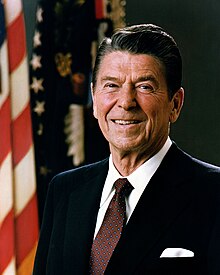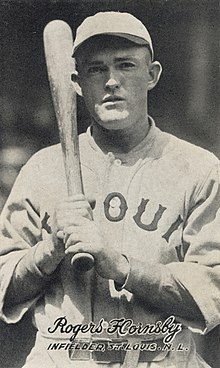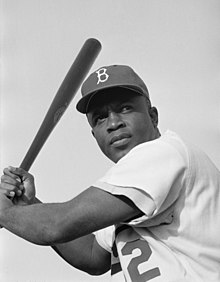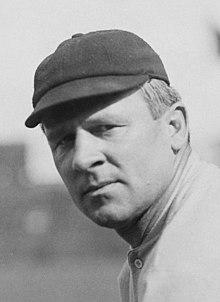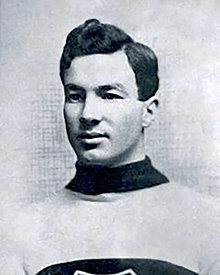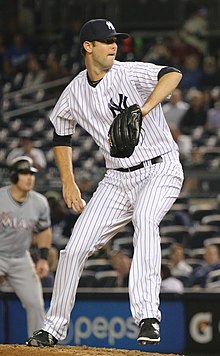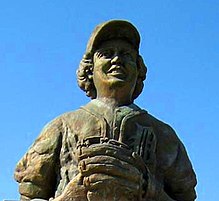Portal:Baseball
Portal maintenance status: (June 2018)
|
| Main page | Content, Categories & Topics | WikiProjects & Things you can do |
The Baseball Portal
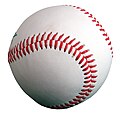
Baseball is a bat-and-ball sport played between two teams of nine players each, taking turns batting and fielding. The game occurs over the course of several plays, with each play generally beginning when a player on the fielding team, called the pitcher, throws a ball that a player on the batting team, called the batter, tries to hit with a bat. The objective of the offensive team (batting team) is to hit the ball into the field of play, away from the other team's players, allowing its players to run the bases, having them advance counter-clockwise around four bases to score what are called "runs". The objective of the defensive team (referred to as the fielding team) is to prevent batters from becoming runners, and to prevent runners' advance around the bases. A run is scored when a runner legally advances around the bases in order and touches home plate (the place where the player started as a batter).
The opposing teams switch back and forth between batting and fielding; the batting team's turn to bat is over once the fielding team records three outs. One turn batting for each team constitutes an inning. A game is usually composed of nine innings, and the team with the greater number of runs at the end of the game wins. Most games end after the ninth inning, but if scores are tied at that point, extra innings are usually played. Baseball has no game clock, though some competitions feature pace-of-play regulations such as the pitch clock to shorten game time.
Baseball evolved from older bat-and-ball games already being played in England by the mid-18th century. This game was brought by immigrants to North America, where the modern version developed. Baseball's American origins, as well as its reputation as a source of escapism during troubled points in American history such as the American Civil War and the Great Depression, have led the sport to receive the moniker of "America's Pastime"; since the late 19th century, it has been unofficially recognized as the national sport of the United States, though in modern times is considered less popular than other sports, such as American football. In addition to North America, baseball spread throughout the rest of the Americas and the Asia–Pacific in the 19th and 20th centuries, and is now considered the most popular sport in parts of Central and South America, the Caribbean, and East Asia, particularly in Japan, South Korea, and Taiwan. (Full article...)
 Featured articles - load new batch
Featured articles - load new batch
-
Image 1
Ronald Wilson Reagan (February 6, 1911 – June 5, 2004) was an American politician and actor who served as the 40th president of the United States from 1981 to 1989. A member of the Republican Party, he became an important figure in the American conservative movement, and his presidency is known as the Reagan era.
Born and raised in Illinois, Reagan graduated from Eureka College in 1932 and was hired the next year as a sports broadcaster in Iowa. In 1937, he moved to California where he became a well-known film actor. During his acting career, Reagan was elected president of the Screen Actors Guild twice, serving from 1947 to 1952 and from 1959 to 1960. In the 1950s, he became the host for General Electric Theater and also worked as a motivational speaker for General Electric. Subsequently, Reagan's "A Time for Choosing" speech during the 1964 U.S. presidential election launched his rise as a leading conservative figure. After being elected governor of California in 1966, he raised the state taxes, turned the state budget deficit into a surplus and implemented harsh crackdowns on university protests. Following his loss to Gerald Ford in the 1976 Republican Party presidential primaries, Reagan won the Republican Party's nomination and then a landslide victory over President Jimmy Carter in the 1980 presidential election. (Full article...) -
Image 2

Ichiro Suzuki was the first high-profile NPB player (second overall) to use the posting system.
The posting system (ポスティングシステム, posutingu shisutemu) is a baseball player transfer system that operates between Nippon Professional Baseball (NPB) and Major League Baseball (MLB). Despite the drafting of the United States – Japanese Player Contract Agreement, unveiled in 1967 to regulate NPB players moving to MLB, problems began to arise in the late 1990s. Some NPB teams lost star players without compensation, an issue highlighted when NPB stars Hideo Nomo and Alfonso Soriano left to play in MLB after using loopholes to void their existing contracts. A further problem was that NPB players had very little negotiating power if their teams decided to deal them to MLB, as when pitcher Hideki Irabu was traded to an MLB team for which he had no desire to play. In 1998, the Agreement was rewritten to address both problems; the result was dubbed the "posting system".
Under this system, when an NPB player is "posted", his NPB team notifies the MLB Commissioner, with the posting fee based on the type of contract a player signs and its value. For minor-league contracts, the fee is a flat 25% of contract's value; for MLB contracts, the fee is based on the value of the contract that the posted player eventually signs. The player is then given 30 days to negotiate with any MLB team willing to pay the NPB team's posting fee. If the player agrees on contract terms with a team before the 30-day period has expired, the NPB team receives the posting fee from the signing MLB team as a transfer fee, and the player is free to play in MLB. If no MLB team comes to a contract agreement with the posted player, then no fee is paid, and the player's rights revert to his NPB team. The current process replaced one in which MLB held a silent auction during which MLB teams submitted sealed, uncapped bids in an attempt to win the exclusive negotiating rights with the posted player for a period of 30 days. Once the highest bidding MLB team was determined, the player could then only negotiate with that team. (Full article...) -
Image 3The 2004 World Series was the championship series of Major League Baseball's (MLB) 2004 season. The 100th edition of the World Series, it was a best-of-seven playoff between the American League (AL) champion Boston Red Sox and the National League (NL) champion St. Louis Cardinals; the Red Sox swept the Cardinals in four games. The series was played from October 23 to 27, 2004, at Fenway Park and Busch Memorial Stadium, broadcast on Fox, and watched by an average of just under 25.5 million viewers. The Red Sox's World Series championship was their first since 1918, ending the Curse of the Bambino.
The Cardinals earned their berth into the playoffs by winning the NL Central division title, and had the best win–loss record in the NL. The Red Sox won the AL wild card to earn theirs. The Cardinals reached the World Series by defeating the Los Angeles Dodgers in the best-of-five NL Division Series and the Houston Astros in the best-of-seven NL Championship Series. The Red Sox defeated the Anaheim Angels in the AL Division Series. After trailing three games to none to the New York Yankees in the AL Championship Series, the Red Sox came back to win the series, advancing to their first World Series since 1986. The Cardinals made their first appearance in the World Series since 1987. With the New England Patriots winning Super Bowl XXXVIII, the World Series victory made Boston the first city to have Super Bowl and World Series championship teams in the same year (2004) since Pittsburgh in 1979. The Red Sox became the third straight wild card team to win the World Series; the Anaheim Angels won in 2002 and the Florida Marlins won in 2003. (Full article...) -
Image 4
Riders Field, formerly known as Dr Pepper/Seven Up Ballpark and Dr Pepper Ballpark, is a baseball park in Frisco, Texas, United States. The home of the Double-A Frisco RoughRiders of the Texas League, it opened on April 3, 2003, and can seat up to 10,216 people. Though primarily a venue for Minor League Baseball games, the facility also hosts high school and college baseball tournaments, and other public and private events throughout the year. It has been the site of three Texas League All-Star Games.
Since its opening, Riders Field has won awards and garnered praise for its unique design, feel, and numerous amenities. In his design, park architect David M. Schwarz desired the creation of a village-like "park within a (ball)park". The stadium received the 2003 Texas Construction Award for Best Architectural Design. (Full article...) -
Image 5Michael Lee Capel (born October 13, 1961) is an American professional baseball pitcher who played in Major League Baseball (MLB) for the Chicago Cubs, the Milwaukee Brewers, and the Houston Astros. In 49 career games, Capel pitched 62+1⁄3 innings, struck out 43 batters, and had a career win–loss record of 3–4 with a 4.62 earned run average (ERA). While he played in MLB, Capel stood at 6 feet 1 inch (185 cm) and weighed 175 pounds (79 kg). A starting pitcher in college and parts of his Minor League Baseball career, he converted to relief pitching while in Chicago's minor league system.
The Philadelphia Phillies chose Capel in the 24th round of the 1980 MLB draft, but the 18-year-old did not sign with the team; instead, he opted to attend the University of Texas. Capel played on the 1982 USA College All-Star Team, which competed in the Amateur World Series in Seoul and placed third. The next year, Capel and the Texas Longhorns won the College World Series. After he was drafted by the Cubs, Capel left Texas and signed to play professional baseball; he played in six seasons of Minor League Baseball before he made his MLB debut in 1988. Capel spent the entire 1989 season in Triple-A, one level below the majors, but the Cubs released him at the end of the year. He agreed to terms with the Brewers and played in MLB after an injury opened a spot on Milwaukee's roster, but was again released at the end of the season. A free agent, the Astros signed Capel, and over the course of the season he pitched in 25 games for the team. He spent the final part of his career in the Astros farm system, and after he made the 1992 Triple-A All-Star team, Capel played his last season in 1993. After retirement, Capel worked as the general manager of a car dealership in Houston, Texas. (Full article...) -
Image 6
Rogers Hornsby (April 27, 1896 – January 5, 1963), nicknamed "the Rajah", was an American baseball infielder, manager, and coach who played 23 seasons in Major League Baseball (MLB). He played for the St. Louis Cardinals (1915–1926, 1933), New York Giants (1927), Boston Braves (1928), Chicago Cubs (1929–1932), and St. Louis Browns (1933–1937). He was named the National League (NL)'s Most Valuable Player (MVP) twice, and was a member of one World Series championship team.
Born in Winters, Texas, and raised in Fort Worth, Texas, Hornsby played for several semi-professional and minor league teams. In 1915, he began his major league career with the St. Louis Cardinals and remained with the team for 12 seasons. During this period, Hornsby won his first MVP Award and the Cardinals won the 1926 World Series. After that season, he spent one season with the New York Giants and another with the Boston Braves before being traded to the Chicago Cubs. He played with the Cubs for four years and won his second MVP Award before the team released him in 1932. Hornsby re-signed with the Cardinals in 1933, but was released partway through the season, effectively ending his career as a full-time player. He was picked up by the St. Louis Browns and remained there until his final season in 1937, though he made only 67 appearances for them as a player. From 1925 to 1937, Hornsby was intermittently a player-manager. After retiring as a player, he managed the Browns in 1952 and the Cincinnati Reds from 1952 to 1953. (Full article...) -
Image 7
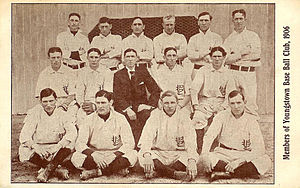
Youngstown Ohio Works (1906), with pitcher Roy Castleton seated in second row, second from left
The Youngstown Ohio Works baseball team was a minor league club that was known for winning the premier championship of the Ohio–Pennsylvania League in 1905, and for launching the professional career of pitcher Roy Castleton a year later. A training ground for several players and officials who later established careers in Major League Baseball, the team proved a formidable regional competitor and also won the 1906 league championship.
During its brief span of activity, the Ohio Works team faced challenges that reflected common difficulties within the Ohio–Pennsylvania League, including weak financial support for teams. Following a dispute over funding, the team's owners sold the club to outside investors, just a few months before the opening of the 1907 season. (Full article...) -
Image 8
Harmon Clayton Killebrew Jr. (/ˈkɪlɪbruː/; June 29, 1936 – May 17, 2011), nicknamed "the Killer" and "Hammerin' Harmon", was an American professional baseball first baseman, third baseman, and left fielder. He spent most of his 22-year career in Major League Baseball (MLB) with the Minnesota Twins. A prolific power hitter, Killebrew had the fifth-most home runs in major league history at the time of his retirement. He was second only to Babe Ruth in American League (AL) home runs, and was the AL career leader in home runs by a right-handed batter. Killebrew was inducted into the National Baseball Hall of Fame in 1984.
Killebrew was 5-foot-11-inch (180 cm) tall and 213 pounds (97 kg). His compact swing generated tremendous power and made him one of the most feared power hitters of the 1960s, when he hit at least 40 home runs per season eight times. In total Killebrew led the league six times in home runs and three times in RBIs, and was named to 13 All-Star teams. In 1965, he played in the World Series with the Twins, who lost to the Los Angeles Dodgers. His finest season was 1969, when he hit 49 home runs, recorded 140 RBIs and won the AL Most Valuable Player Award while helping lead the Twins to the AL West pennant. (Full article...) -
Image 9

Hershiser pitching for the Dodgers in 1993
During the 1988 Major League Baseball season, pitcher Orel Hershiser of the Los Angeles Dodgers set the MLB record for consecutive scoreless innings pitched. Over 59 consecutive innings, opposing hitters did not score a run against Hershiser. During the streak, he averted numerous high-risk scoring situations. The streak spanned from the sixth inning of an August 30 game against the Montreal Expos to the 10th inning of a September 28 game against the San Diego Padres. The previous record of 58+2⁄3 innings was set by former Dodger pitcher Don Drysdale in 1968; as the team's radio announcer, Drysdale called Hershiser's streak as he pursued the new record. Pundits have described the streak as among the greatest records in baseball history, with one pundit ranking it among the greatest individual feats in American sports.
During the streak, the Elias Sports Bureau changed its criteria for the official consecutive scoreless innings record for starting pitchers from including fractional innings in which one or two outs had been recorded to counting only complete scoreless innings. Since the streak was active at the end of the 1988 season, it could have spanned two separate seasons. However, Hershiser yielded a run in his first inning of work in the 1989 season against the Cincinnati Reds, thus ending the streak at 59 consecutive scoreless innings pitched. The streak includes only innings pitched in the regular season, excluding eight scoreless innings Hershiser pitched to start Game 1 of the 1988 National League Championship Series on October 4 (unofficially extending his streak to 67 combined innings). Although he completed the ninth inning in each start, the streak's final game lasted 16 innings, of which he pitched only the first 10. Thus, Hershiser did not match Drysdale's record of six consecutive complete game shutouts. Like Drysdale's streak, the penultimate game of Hershiser's streak was a Dodgers–Giants game that featured a controversial umpire's ruling that saved the streak. (Full article...) -
Image 10
Jack Roosevelt Robinson (January 31, 1919 – October 24, 1972) was an American professional baseball player who became the first African-American to play in Major League Baseball (MLB) in the modern era. Robinson broke the color line when he started at first base for the Brooklyn Dodgers on April 15, 1947. The Dodgers signing Robinson heralded the end of racial segregation in professional baseball, which had relegated black players to the Negro leagues since the 1880s.
Born in Cairo, Georgia, Robinson was raised in Pasadena, California. A four-sport student athlete at Pasadena Junior College and the University of California, Los Angeles, he was better known for football than he was for baseball, becoming a star college player with the UCLA Bruins football team. Following his college career, Robinson was drafted for service during World War II but was court-martialed for refusing to sit at the back of a segregated Army bus, eventually being honorably discharged. Afterwards, he signed with the Kansas City Monarchs of the Negro leagues, where he caught the eye of Branch Rickey, general manager of the Brooklyn Dodgers, who thought he would be the perfect candidate for breaking the color line in MLB. (Full article...) -
Image 11
Arthur Joseph Houtteman (August 7, 1927 – May 6, 2003) was an American right-handed pitcher in Major League Baseball who played for 12 seasons in the American League with the Detroit Tigers, Cleveland Indians and Baltimore Orioles. In 325 career games, Houtteman pitched 1,555 innings and posted a win–loss record of 87–91, with 78 complete games, 14 shutouts, and a 4.14 earned run average (ERA).
Known on the sandlot for his pitching motion, Houtteman was signed by scout Wish Egan in 1945 at 17 years of age. He was recruited by major league teams, and joined a Tigers pitching staff that had lost players to injuries and World War II. After moving between the major and minor leagues over the next few years, he was nearly killed in an automobile accident just before the 1949 season. Houtteman rebounded from his injuries and went on to win 15 games that season and made his only All-Star appearance in the following year. (Full article...) -
Image 12
Kenesaw Mountain Landis (/ˈkɛnɪsɔː ˈmaʊntɪn ˈlændɪs/; November 20, 1866 – November 25, 1944) was an American jurist who served as a United States federal judge from 1905 to 1922 and the first commissioner of baseball from 1920 until his death. He is remembered for his resolution of the Black Sox Scandal, in which he expelled eight members of the Chicago White Sox from organized baseball for conspiring to lose the 1919 World Series and repeatedly refused their reinstatement requests. His iron rule over baseball in the near quarter-century of his commissionership is generally credited with restoring public confidence in the game.
Landis was born in Millville, Ohio. Raised in Indiana, he became a lawyer, and then personal secretary to Walter Q. Gresham, the new United States Secretary of State, in 1893. He returned to private practice after Gresham died in office. (Full article...) -
Image 13
John Joseph McGraw (April 7, 1873 – February 25, 1934) was an American Major League Baseball (MLB) player and manager who was for almost thirty years manager of the New York Giants. He was also the third baseman of the pennant-winning 1890s Baltimore Orioles teams, noted for their innovative, aggressive play.
McGraw was born into poverty in Truxton, New York. He found an escape from his hometown and a bad family situation through baseball, beginning a quick rise through the minor leagues that led him to the Orioles at the age of 18. Under the tutelage of manager Ned Hanlon, the Orioles of the 1890s won three National League (NL) pennants; McGraw was one of the stalwarts of the team alongside Wee Willie Keeler, Hughie Jennings, and Wilbert Robinson. The Orioles perfected the hit and run play and popularized the Baltimore chop; they also sought to win by intimidating the opposing team and the umpire. (Full article...) -
Image 14
Marcus Elmore Baldwin (October 29, 1863 – November 10, 1929), nicknamed "Fido" and "Baldy", was an American professional baseball pitcher who played seven seasons in Major League Baseball (MLB). In 346 career games, he pitched to a 154–165 win–loss record with 295 complete games. Baldwin set the single-season MLB wild pitches record with 83 that still stands today.
Born in Pittsburgh, Pennsylvania, Baldwin made his professional debut for a Cumberland, Maryland, team in 1883. Though signed by Chicago White Stockings president Albert Spalding to pitch against the St. Louis Browns in the 1886 World Series, Baldwin did not play after the Browns objected. He made his MLB debut for the White Stockings in 1887, when a writer for the Oshkosh Daily Northwestern called him the "swiftest pitcher in the National League" (NL). Released by Chicago player–manager Cap Anson, he signed with the Columbus Solons of the American Association (AA) in 1889, where he led the league in innings pitched (513+2⁄3), losses (34), strikeouts (368), and walks (274). (Full article...) -
Image 15Ross with the Montreal Wanderers, circa 1907–18
Arthur Howey Ross (January 13, 1885 – August 5, 1964) was a Canadian professional ice hockey player and executive from 1905 until 1954. Regarded as one of the best defenders of his era by his peers, he was one of the first to skate with the puck up the ice rather than pass it to a forward. He was on Stanley Cup championship teams twice in a playing career that lasted thirteen seasons; in January 1907 with the Kenora Thistles and 1908 with the Montreal Wanderers. Like other players of the time, Ross played for several different teams and leagues, and is noted for his time with the Wanderers while they were members of the National Hockey Association (NHA) and its successor, the National Hockey League (NHL). In 1911, he led one of the first organized player strikes over increased pay. When the Wanderers' home arena burned down in January 1918, the team ceased operations and Ross retired as a player.
After several years as an on-ice official, he was named head coach of the Hamilton Tigers for one season. When the Boston Bruins were formed in 1924, Ross was hired as the first coach and general manager of the team. He later coached the team on three separate occasions until 1945, and stayed as general manager until his retirement in 1954. Ross helped the Bruins finish first place in the league ten times and win the Stanley Cup three times; Ross personally coached the team to two of those victories. After being hired by the Bruins, Ross, along with his wife and two sons, moved to a suburb of Boston, and he became an American citizen in 1938. He died near Boston in 1964. (Full article...)
General images - load new batch
-
Image 1A New York Yankees batter (Andruw Jones) and a Boston Red Sox catcher at Fenway Park (from Baseball)
-
Image 3Cy Young—the holder of many major league career marks, including wins and innings pitched, as well as losses—in 1908. MLB's annual awards for the best pitcher in each league are named for Young. (from Baseball)
-
Image 5Baseball games sometimes end in a walk-off home run, with the batting team usually gathering at home plate to celebrate the scoring of the winning run(s). (from Baseball rules)
-
Image 6Rickey Henderson—the major leagues' all-time leader in runs and stolen bases—stealing third base in a 1988 game (from Baseball)
-
Image 7By the 1860s Civil War, baseball (bottom) had overtaken its fellow bat-and-ball sport cricket (top) in popularity within the United States. (from History of baseball)
-
Image 9In May 2010, the Philadelphia Phillies' Roy Halladay pitched the 20th major league perfect game. That October, he pitched only the second no-hitter in MLB postseason history. (from History of baseball)
-
Image 10The strike zone determines the result of most pitches, and varies in vertical length for each batter. (from Baseball)
-
Image 11Cover of Official Base Ball Rules, 1921 edition, used by the American League and National League (from Baseball rules)
-
Image 12Jackie Robinson in 1945, with the era's Kansas City Royals, a barnstorming squad associated with the Negro American League's Kansas City Monarchs (from History of baseball)
-
Image 13Sadaharu Oh managing the Japan national team in the 2006 World Baseball Classic. Playing for the Central League's Yomiuri Giants (1959–80), Oh set the professional world record for home runs. (from Baseball)
-
Image 14Pitchers are generally substituted during mound visits (team gatherings at the pitcher's mound). (from Baseball rules)
-
Image 15Pesäpallo, a Finnish variation of baseball, was invented by Lauri "Tahko" Pihkala in the 1920s, and after that, it has changed with the times and grown in popularity. Picture of Pesäpallo match in 1958 in Jyväskylä, Finland. (from Baseball)
-
Image 162013 World Baseball Classic championship match between the Dominican Republic and Puerto Rico, March 20, 2013 (from Baseball)
-
Image 17An Afghan girl playing baseball in August 2002 (from Baseball)
-
Image 19A first baseman receives a pickoff throw, as the runner dives back to first base. (from Baseball)
-
Image 20The NL champion New York Giants baseball team, 1913. Fred Merkle, sixth in line, had committed a baserunning gaffe in a crucial 1908 game that became famous as Merkle's Boner. (from History of baseball)
-
Image 21A well-worn baseball (from Baseball)
-
Image 22The strike zone, which determines the outcome of most pitches, varies in vertical length depending on the batter's typical height while swinging. (from Baseball rules)
-
Image 23A runner sliding into home plate and scoring. (from Baseball)
-
Image 24Diagram of a baseball field Diamond may refer to the square area defined by the four bases or to the entire playing field. The dimensions given are for professional and professional-style games. Children often play on smaller fields. (from Baseball)
-
Image 26Japanese-Americans spectating a World War II-era game while in an internment camp. America's ties to immigrants and to Japan have been deeply shaped by a shared baseball heritage. (from History of baseball)
-
Image 271906 World Series, infielders playing "in" for the expected bunt and the possible play at the plate with the bases loaded (from Baseball rules)
-
Image 28Fenway Park, home of the Boston Red Sox. The Green Monster is visible beyond the playing field on the left. (from Baseball)
-
Image 29Pick-off attempt on runner (in red) at first base (from Baseball rules)
-
Image 30Sadaharu Oh managing the Japan national team in the 2006 World Baseball Classic. Playing for the Central League's Yomiuri Giants (1959–80), Oh set the professional world record for home runs with 868. (from History of baseball)
-
Image 31A game from the Cantigas de Santa Maria, c. 1280, involving tossing a ball, hitting it with a stick and competing with others to catch it (from History of baseball)
-
Image 32Alexander Cartwright, father of modern baseball (from History of baseball)
-
Image 34The standard fielding positions (from Baseball rules)
-
Image 36Two players on the baseball team of Tokyo, Japan's Waseda University in 1921 (from Baseball)
-
Image 37A batter follows through after swinging at a pitched ball. (from Baseball rules)
-
Image 38Defensive positions on a baseball field, with abbreviations and scorekeeper's position numbers (not uniform numbers) (from Baseball)
-
Image 39Jackie Robinson in 1945, with the era's Kansas City Royals, a barnstorming squad associated with the Negro American League's Kansas City Monarchs (from Baseball)
-
Image 40Baserunners generally stand a short distance away from their base between pitches, preparing themselves to either go back or steal the next base. (from Baseball rules)
-
Image 41The American Tobacco Company's line of baseball cards featured shortstop Honus Wagner of the Pittsburgh Pirates from 1909 to 1911. In 2007, the card shown here sold for $2.8 million. (from Baseball)
-
Image 42A pitcher handing off the ball after being taken out of the game during a mound meeting. (from Baseball)
-
Image 45The typical motion of a right-handed pitcher (from Baseball rules)
 Good articles - load new batch
Good articles - load new batch
-
Image 1Addie Joss in 1902
The Addie Joss Benefit Game was an exhibition baseball game played between the Cleveland Naps of the American League and an all-star team composed of players from the league's other teams at League Park in Cleveland, Ohio, on July 24, 1911. The game was planned as a benefit for the family of Addie Joss, a pitcher for the Naps who died in April. The all-stars defeated the Naps, 5–3, and the game raised $12,914 for the Joss family ($422,288 in current dollar terms).
Following Joss's death, Cleveland's management announced their plans to put on a benefit for his widow and two young children. Star players from other teams volunteered to form an all-star team to play against the Naps. Paid attendance was 15,272, and many players and team owners contributed money to the Joss family as well. The benefit game preceded the creation of the Major League Baseball All-Star Game, first contested in 1933, which raises money for the players' pension fund. (Full article...) -
Image 2
Édgar Enrique Rentería Herazo (Spanish pronunciation: [ˈeðɣaɾ renteˈɾi.a]; born August 7, 1975), nicknamed "the Barranquilla Baby", is a Colombian former professional baseball shortstop. He threw and batted right-handed. He played for the Florida Marlins, St. Louis Cardinals, Boston Red Sox, Atlanta Braves, Detroit Tigers, San Francisco Giants, and Cincinnati Reds.
Born in Barranquilla, Colombia, Rentería was signed by the Florida Marlins in 1992. He debuted with them in 1996, and he finished second to Todd Hollandsworth in Rookie of the Year Award balloting. In 1997, his RBI single off Charles Nagy in the eleventh inning of Game 7 of the 1997 World Series won the first World Series in Marlins' history over the Cleveland Indians. In the 2010 World Series against the Texas Rangers, Rentería won the World Series Most Valuable Player Award with the San Francisco Giants after he hit game-winning home runs in Game 2 and Game 5. (Full article...) -
Image 3
Perce Leigh "Pat" Malone (September 25, 1902 – May 13, 1943) was an American pitcher in Major League Baseball who played from for the Chicago Cubs (1928–1934) and New York Yankees (1935–1937). Listed at 6 feet 0 inches (1.83 m) and 200 pounds (91 kg), Malone batted left-handed and threw right-handed. He played for four pennant winners and two World Series champions.
Born in Altoona, Pennsylvania, Malone started playing semipro baseball when a teenager. Initially signed by the New York Giants in 1922, his hard-drinking lifestyle brought him in conflict with manager John McGraw, who sold his contract to the minor league Minneapolis Millers after 1924 spring training. Malone would spend six years in the minor leagues, but after successful seasons in 1926 and 1927, was signed by the Cubs before the 1928 season. (Full article...) -
Image 4
Matthew Ryan Kemp (born September 23, 1984) is an American former professional baseball outfielder. He began his professional career in the Los Angeles Dodgers organization in 2003, and played in Major League Baseball (MLB) with the Dodgers from 2006 until 2014, the San Diego Padres in 2015 and 2016 and the Atlanta Braves in 2016 and 2017 before returning to the Dodgers for the 2018 season, and briefly playing for the Cincinnati Reds in 2019 and Colorado Rockies in 2020. He was named to three All-Star teams and won two Gold Glove Awards (2009 and 2011) and two Silver Slugger Awards (2009 and 2011).
The Dodgers selected Kemp in the sixth round of the 2003 MLB draft. After four seasons in the minor leagues, he made his major league debut in 2006. He did not become a full-time player until 2008, when he took over as the starting center fielder for the Dodgers. In 2011, Kemp led the National League in runs scored (115), total bases (353), OPS+ (171), WAR (7.8), home runs (39), and runs batted in (126). Additionally, he became the first player to finish in the top two in both home runs and steals since Hank Aaron in 1963. (Full article...) -
Image 5Harry Hamlet East (April 12, 1862 – June 1, 1905) was an American professional baseball player who played in one game at third base for the Baltimore Orioles of the American Association in 1882. A St. Louis native, he was hitless in four at bats as the Orioles lost 10–5 to the St. Louis Browns at Sportsman's Park. He played two seasons of Minor league baseball as well, then became a doctor. After being admitted to a hospital with melancholia in 1905, East slit his throat with a straight razor, committing suicide at the age of 43. (Full article...)
-
Image 6
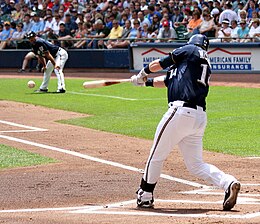
Casey McGehee on the Milwaukee Brewers puts a ball in play
In the sports of baseball and softball, a batted ball is a pitch that has been contacted by the batter's bat. Batted balls are either fair or foul, and can be characterized as a fly ball, pop-up, line drive, or ground ball. In baseball, a foul ball counts as a strike against the batter, unless there are already two strikes on the batter, with special rules applying to foul tips and foul bunts. Fly balls are those hit in an arcing manner, with pop-ups being a subset of fly balls that do not travel far. Line drives are batted balls hit on a straight line trajectory, while ground balls are hit at a low trajectory, contact the ground shortly after being hit, and then either roll or bounce. Batted balls, especially line drives, can present a hazard to players, umpires, and spectators, as people have been seriously injured or killed after being struck by batted balls. (Full article...) -
Image 7Babe Ruth lying in state in the rotunda of the old Yankee Stadium
Babe Ruth died on August 16, 1948, from a type of throat cancer. He underwent hormone therapy, and surgery in an attempt to treat his cancer. He was also one of the first cancer patients to receive sequential radiation and chemotherapy treatment. The treatments were not successful.
His funeral took place over three days, from August 17 to August 19, 1948. Ruth was a well-known Major League Baseball player who played for the New York Yankees for fifteen years. His funeral included a two-day open casket funeral at Yankee Stadium, a mass at St. Patrick's Cathedral and a burial at the Gate of Heaven Cemetery. The funeral events were attended by many prominent people. A total of 57 honorary pallbearers were appointed for his funeral. (Full article...) -
Image 8Martin with the New York Yankees in 2015
Christopher Riley Martin (born June 2, 1986) is an American professional baseball pitcher who is a free agent. He has played in Major League Baseball (MLB) for the Colorado Rockies, New York Yankees, Texas Rangers, Atlanta Braves, Chicago Cubs, Los Angeles Dodgers and Boston Red Sox and in Nippon Professional Baseball (NPB) for the Hokkaido Nippon-Ham Fighters.
Martin played baseball at Arlington High School and McLennan Community College, but gave up on baseball after he suffered a shoulder injury. After working in a warehouse for three years, Martin began playing catch, and felt strong enough to try out for independent league baseball. After he pitched for the Grand Prairie AirHogs in 2010, the Boston Red Sox of MLB signed Martin in 2011. He pitched in Minor League Baseball for the Red Sox organization, until they traded him to the Rockies after the 2013 season. (Full article...) -
Image 9
On June 17, 1880, John Montgomery Ward of the Providence Grays threw a perfect game against the Buffalo Bisons at Messer Street Grounds. It was the second perfect game in Major League Baseball history, which at the time only consisted of the National League (NL). Ward's perfect game occurred just five days after Lee Richmond's perfect game.
Ward was one of the best pitchers in the NL, and posted a 1.74 earned run average in 1880. Due to limited reporting from contemporary sources, little is known about Ward's perfect game outside of the box score. The opposing pitcher was Pud Galvin, who allowed five runs in nine innings. One newspaper noted there were a couple of strong defensive plays that helped preserve Ward's perfect game, such as a difficult catch made by center fielder Paul Hines, and "some wonderful stops" by shortstop John Peters. (Full article...) -
Image 10
Edwar Emilio Ramírez (born 28 March 1981) is a Dominican former professional baseball pitcher. Ramírez appeared in Major League Baseball (MLB) as a relief pitcher for the New York Yankees (2007–2009) and Oakland Athletics (2010). After finding himself out of baseball in 2004, Ramírez revitalized his career by developing an effective changeup.
Originally a member of the Los Angeles Angels of Anaheim organization, Ramírez pitched for the Angels only in minor league baseball. The Angels released Ramírez before the 2004 season. After spending the next year mastering a changeup, he spent parts of the following two seasons in independent league baseball. Ramírez signed with the Yankees in 2006, and made his MLB debut the next season. Ramírez enjoyed success and popularity among the fan base during the 2007 and 2008 seasons. He struggled in 2009, and pitched for the Athletics early in the 2010 season before returning to minor league baseball in the Athletics organization. He pitched in the Mexican League in 2011. (Full article...) -
Image 11
Barry William Zito (born May 13, 1978) is an American former professional baseball pitcher. He played 15 seasons in Major League Baseball (MLB) for the Oakland Athletics and San Francisco Giants. His pitching repertoire consisted of a curveball (his strikeout pitch), a four-seam fastball, a two-seam fastball, a circle changeup, and a cutter–slider.
Zito attended the University of California, Santa Barbara, Los Angeles Pierce College, and the University of Southern California. Drafted three times while in college, Zito signed with the Athletics when they chose him in the first round of the 1999 MLB draft. A year later, he was in the major leagues, finishing sixth in American League (AL) Rookie of the Year Award voting. He struggled to begin the 2001 season but improved greatly down the stretch, finishing the year with an 11–1 win–loss record over his final two months. He won 23 games (while only losing five) in 2002 and won the Cy Young Award. His record was only 14–12 in 2003, but he still made the All-Star team for the second year in a row. In 2004, he had his worst season, going 11–11 with a career-high 4.48 earned run average. He became Oakland's Opening Day starter in 2005 and finished fifth in the AL with 171 strikeouts. In 2006, he made the All-Star team and posted a 15–1 record when receiving two or more runs. (Full article...) -
Image 12

Henry Eugene Bearden (September 5, 1920 – March 18, 2004) was an American professional baseball pitcher, a left-hander who played in Major League Baseball (MLB) from 1947 to 1953 for the Cleveland Indians, Washington Senators, Detroit Tigers, St. Louis Browns and Chicago White Sox. In 193 career games, Bearden pitched 7881⁄3 innings and posted a win–loss record of 45–38, with 29 complete games, seven shutouts, 259 strikeouts, and a 3.96 earned run average (ERA).
Born in Lexa, Arkansas, Bearden was signed to a contract by the Philadelphia Phillies out of high school, and spent four seasons in the minor leagues. He then served in the United States Navy during World War II aboard the USS Helena. He was wounded during the Battle of Kula Gulf and was hospitalized until 1945 when he made a return to baseball. After two years in the New York Yankees organization, Bearden was traded to the Cleveland Indians and made his MLB debut in 1947, making one appearance that year. (Full article...) -
Image 13Statue of López in Tecamachalco, Puebla
Aurelio Alejandro López Rios (September 21, 1948 – September 22, 1992) was a Mexican professional baseball player. After pitching for several years in the Mexican League, he spent eleven seasons (1974, 1978–87) with four teams in Major League Baseball — a majority of it spent with the Detroit Tigers. He acquired the nickname "Señor Smoke" in Detroit, while he was known as "El Buitre de Tecamachalco" (The Vulture of Tecamachalco) in Mexico. López was discovered in his hometown by Mexican League scouts and converted from a starting pitcher to a relief pitcher.
López led the Mexico City Reds to the 1974 Mexican League World Series, then made a brief MLB debut with the Kansas City Royals before returning to the Mexican League. López was named the 1977 Mexican League Most Valuable Player (MVP). He returned to the major leagues with the St. Louis Cardinals in 1978 and pitched for the Detroit Tigers between 1979 and 1985. López finished seventh in the Cy Young Award voting in 1979. He earned a 10–1 record and 14 saves for Detroit's 1984 World Series championship team. (Full article...) -
Image 14

Andrew Bernard "Barney" Gilligan (January 3, 1856 – April 1, 1934) was an American professional baseball player whose career spanned 12 seasons, 11 of which were spent with the Major League Baseball (MLB) Cleveland Blues (1879–1880), Providence Grays (1881–1885), Washington Nationals (1886–1887), and Detroit Wolverines (1888). Gilligan, who predominately played as a catcher, also played as an outfielder and a shortstop. Over his career, Gilligan compiled a career batting average of .207 with 217 runs scored, 388 hits, 68 doubles, 23 triples, three home runs, and 167 runs batted in (RBI) in 523 games played. Although the majority of his career was spent in the major leagues, Gilligan also played in minor league baseball. He was listed as standing 5 feet 6 inches (168 cm) and weighing 130 pounds (59 kg). (Full article...) -
Image 15

2010 BBWAA inductee Andre Dawson
Elections to the Baseball Hall of Fame for 2010 proceeded according to rules enacted in 2001 and revised in 2007. As always, the Baseball Writers' Association of America (BBWAA) voted by mail to select from a ballot of recent players; one player was elected, Andre Dawson.
In keeping with the 2007 reform, one Veterans Committee convened to consider a ballot of managers and umpires, another to consider a ballot of executives. One manager and one umpire were elected: Whitey Herzog and Doug Harvey, respectively. (Full article...)
Did you know (auto-generated) - load new batch

- ... that the only run scored by John Gamble was a game-winner?
- ... that Dominic Keegan refused a position on the New York Yankees to "go back and win another championship" for his college baseball team?
- ... that the ownership group of San Diego's MLS team includes a Native American tribe and baseball player Manny Machado?
- ... that Jenny Cavnar is the first female primary play-by-play announcer in Major League Baseball history?
- ... that the infield of Garvey, Lopes, Russell and Cey played together longer than any other infield foursome in Major League Baseball?
- ... that Kelsie Whitmore was part of the first all-female battery in a professional baseball league since the All-American Girls Professional Baseball League?
- ... that Drew Golz, who was Baseball Academic All-American of the Year and Soccer Academic All-American of the Year, became the first male student athlete to be named Academic All-American of the year for two sports at the same time?
- ... that Julie Croteau is credited as being the first woman to play National Collegiate Athletic Association men's college baseball?
Quotes
| I bleed Dodger blue and when I die, I'm going to the big Dodger in the sky. |
 Featured lists - load new batch
Featured lists - load new batch
-
Image 1

In Major League Baseball (MLB), the 20–20–20 club is the group of batters who have collected 20 doubles, 20 triples and 20 home runs in a single season. Frank Schulte was the first to achieve this, doing so in 1911. The last players to reach the milestone – Curtis Granderson and Jimmy Rollins – attained 20–20–20 during the 2007 season. This marked the first time that two players accomplished the achievement in the same season.
In total, seven players are members of the 20–20–20 club. Of these, five were left-handed batters, one was right-handed and one was a switch hitter, meaning he could bat from either side of the plate. Two players – George Brett and Willie Mays – are also members of the 3,000 hit club, and Mays is also a member of the 500 home run club. Schulte, Rollins, and Jim Bottomley won the Most Valuable Player (MVP) Award in the same year as their 20–20–20 season. Both Mays and Rollins joined the club while also hitting 30 home runs and stealing 30 bases that same season to join the 30–30 club. Brett and Rollins collected more than 200 hits alongside achieving 20–20–20. Furthermore, four players amassed 20 or more stolen bases during their 20–20–20 season. These players are collectively referred to as the 20–20–20–20 club. (Full article...) -
Image 2
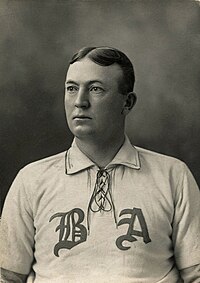
Cy Young is the all-time leader in wins.
In Major League Baseball, the 300-win club is the group of pitchers who have won 300 or more games. Twenty-four pitchers have reached this milestone. This list does not include Bobby Mathews who won 297 in the major leagues plus several more in 1869 and 1870 before the major leagues were established in 1871. The San Francisco Giants are the only franchise to see four players reach 300 wins while on their roster: Tim Keefe in the Players' League, Christy Mathewson and Mickey Welch while the team was in New York, and most recently Randy Johnson. Early in the history of professional baseball, many of the rules favored the pitcher over the batter; the distance pitchers threw to home plate was shorter than today, and pitchers were able to use foreign substances to alter the direction of the ball. Moreover, a schedule with rest days after most games allowed pitchers to start a far higher proportion of their team's games than modern pitchers do, typically every other game or even more (in the second half of the 1884 season Old Hoss Radbourn started 40 games out of 43). The first player to win 300 games was Pud Galvin in 1888. Seven pitchers recorded all or the majority of their career wins in the 19th century: Galvin, Cy Young, Kid Nichols, Keefe, John Clarkson, Charles Radbourn, and Welch. Four more pitchers joined the club in the first quarter of the 20th century: Mathewson, Walter Johnson, Eddie Plank, and Grover Cleveland Alexander. Young is the all-time leader in wins with 511, a mark that is considered unbreakable. If a modern-day pitcher won 20 games per season for 25 seasons, he would still be 11 games short of Young's mark.
Only three pitchers—Lefty Grove, Warren Spahn, and Early Wynn—joined the 300-win club between 1924 and 1982, which may be explained by a number of factors: the abolition of the spitball; World War II military service, such as Bob Feller's; and the growing importance of the home run in the game. As the home run became commonplace, the physical and mental demands on pitchers dramatically increased, which led to the use of a four-man starting rotation. Between 1982 and 1990, the 300-win club gained six members: Gaylord Perry, Phil Niekro, Steve Carlton, Nolan Ryan, Don Sutton, and Tom Seaver. These pitchers benefited from baseball's increase from a 154-game schedule to a 162-game schedule in 1961, and expansion of the league from 16 teams in 1960 to 26 by 1977. The increased use of specialized relief pitchers, an expanded strike zone, and new stadiums, including Shea Stadium, Dodger Stadium and the Astrodome, that were pitcher's parks all also suppressed offensive production. Also, the increasing sophistication of training methods and sports medicine - such as Tommy John surgery - allowed players to maintain a high competitive level for a longer time. Randy Johnson, for example, won more games in his 40s than he did in his 20s. (Full article...) -
Image 3The Hutch Award is given annually to an active Major League Baseball (MLB) player who "best exemplifies the fighting spirit and competitive desire" of Fred Hutchinson, by persevering through adversity. The award was created in 1965 in honor of Hutchinson, the former MLB pitcher and manager, who died of lung cancer the previous year. The Hutch Award was created by Hutch's longtime friends Bob Prince, a broadcaster for the Pittsburgh Pirates and KDKA; Jim Enright, a Chicago sportswriter; and Ritter Collett, the sports editor of the Dayton Journal Herald. They also created a scholarship fund for medical students engaged in cancer research to honor Hutchinson's memory.
Eleven members of the National Baseball Hall of Fame have won the Hutch Award. The inaugural winner was Mickey Mantle. Danny Thompson, the 1974 recipient, was diagnosed with leukemia earlier that year. He continued to play through the 1976 season before dying that December at the age of 29. Jon Lester won the award in 2008 after recovering from anaplastic large-cell lymphoma. (Full article...) -
Image 4

Tim Dillard is the Sounds' career leader in wins (48), games pitched (242), innings pitched (710), and strikeouts (437).
The Nashville Sounds Minor League Baseball team has played in Nashville, Tennessee, since being established in 1978 as an expansion team of the Double-A Southern League. They moved up to Triple-A in 1985 as members of the American Association before joining the Pacific Coast League in 1998. The team was placed in the Triple-A East in 2021 prior to this becoming the International League in 2022. In the history of the franchise, numerous players and teams have set records in various statistical areas during single games, entire seasons, or their Sounds careers.
Of the nine Sounds who hold the 19 career records tracked by the team, Tim Dillard holds the most, with seven. He is followed by Skeeter Barnes and Chad Hermansen, with three each; and Keith Brown, Mark Corey, Hugh Kemp, Otis Nixon, Tike Redman, and Joey Wendle, with one apiece. Dillard holds the most franchise records, with eight. He is followed by Jamie Werly, with six; and Steve Balboni and Skeeter Barnes, who hold four records each. (Full article...) -
Image 5
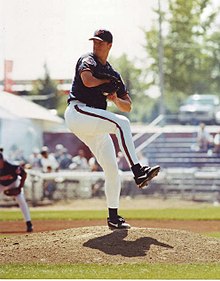
Jim Abbott (1988), born without a right hand, won the 1987 Golden Spikes Award, the 1992 Tony Conigliaro Award, and the 1995 Hutch Award.
The Los Angeles Angels are a Major League Baseball (MLB) franchise based in Anaheim, California. They play in the American League (AL) West division. Since the institution of Major League Baseball's Rule 4 Draft in 1965, the Angels have selected 62 players in the first round. Officially known as the "First-Year Player Draft", the Rule 4 Draft is Major League Baseball's primary mechanism for assigning amateur players from high schools, colleges, and other amateur clubs to its teams. The draft order is determined based on the previous season's standings, with the team possessing the worst record receiving the first pick. In addition, teams which lost free agents in the previous off-season may be awarded compensatory or supplementary picks.
Of the 66 players drafted by the Angels, 29 have been pitchers, the most of any position; 18 of these were right-handed, while 11 were left-handed. Fourteen outfielders, eight shortstops, four third basemen, and four first basemen were also taken. No second basemen have been selected. Thirteen of the players came from high schools or universities in the state of California, while Florida follows with six players. Four players have been selected from both Illinois and Georgia. All players selected have been from the United States. The franchise has made five selections in the same draft three times, in 1986, 2009, and 2010. (Full article...) -
Image 6

Jewish players have played in Major League Baseball since the league came into existence in the late 19th century, and have a long and storied history within the game. There have been 190 players who identified as Jewish during their Major League career, including players who converted during or before their careers, and players who have or had at least one Jewish parent, and identified as Jewish by virtue of their parentage.
In the early years, Jewish baseball players faced constant antisemitic heckles from opponents and fans, with many hiding their heritage to avoid discrimination in the league. Despite this, a number of Jewish players overcame such abuse and went on to become stars. Two such players, Hank Greenberg and Sandy Koufax, were both elected to the Baseball Hall of Fame and are widely considered to be amongst the most important and iconic players in baseball and American history. The sport played a large part in the assimilation of American Jews into American society at a time of rampant antisemitism, and remains a very important part in Jewish American culture today. (Full article...) -
Image 7

Orlando Hernández won gold with the Cuban team in the 1992 Summer Olympics, baseball's first appearance as an Olympic medal sport.
Baseball is a sport formerly contested at the Summer Olympic Games. It was originally played as a demonstration sport in seven Olympics—1912, 1936, 1952, 1956, 1964, 1984, and 1988— more than for any other sport in Olympic history. These exhibitions featured a single game at the first five Olympic appearances and then a tournament format in 1984 and 1988. The International Olympic Committee (IOC) granted baseball official status on October 13, 1986, for the 1992 Summer Olympics. The sport was contested at each subsequent Games through 2008, after which the IOC removed it from the roster of Olympic sports.
In 1992, the first official Olympic baseball tournament was won by the Cuban team. Cuba had boycotted the 1984 and 1988 Olympics, missing the previous exhibition baseball tournaments, but entered in 1992 as the favorite, having won the past 12 world championships and with a 62–1 record in international competitions since 1986. The Cubans went undefeated in the 1992 Olympics and trailed in only one game. They went undefeated again at the 1996 Olympics en route to a second consecutive gold medal. The United States won their first medal (bronze) in the 1996 Olympics and then won gold at the 2000 Summer Olympics. 2000 was the first Olympics in which Cuba lost a game: first to the Dutch team in round-robin play and then again to the Americans in the gold medal game. This was also the first time professional players were allowed to compete in baseball, though Major League Baseball (MLB) did not permit any player on the 40-man roster of an MLB team to compete. In 2004, the reigning gold medalist United States did not qualify for the Olympic tournament, while the Cuban team won its third gold medal. (Full article...) -
Image 8The Oakland Athletics are a professional baseball team based in Oakland, California. Before moving to Oakland in 1968, the team played in Philadelphia, Pennsylvania from 1901 through 1954 and in Kansas City, Missouri from 1955 through 1967. The Athletics are members of the American League (AL) West division in Major League Baseball (MLB). In baseball, the head coach of a team is called the manager, or more formally, the field manager. The duties of the team manager include team strategy and leadership on and off the field. The team has employed 30 different managers in its history. The current Athletics' manager is Mark Kotsay.
The franchise's first manager was Hall of Famer Connie Mack, who managed the team for its first fifty seasons. Mack led the Athletics to nine AL championships and five World Series championships—in 1910, 1911, 1913, 1929 and 1930. The team lost the World Series in 1905, 1914 and 1931, and no World Series was played when the Athletics won the AL championship in 1902. After Jimmy Dykes replaced Mack as the Athletics' manager in 1951, no manager served more than three consecutive seasons until Tony La Russa, who became the Athletics' manager in 1986. During this period, Dick Williams managed the Athletics to two consecutive World Series championships in 1972 and 1973, and Alvin Dark managed the team to a third consecutive World Series championship in 1974. La Russa managed the Athletics to three consecutive AL championships from 1988 through 1990, winning the World Series in 1989. (Full article...) -
Image 9
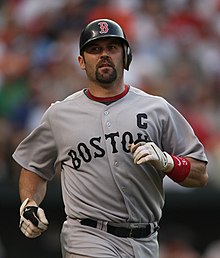
An All-American team is an honorary sports team composed of the best amateur players of a specific season for each position—who in turn are given the honorific "All-America" and typically referred to as "All-American athletes", or simply "All-Americans". Although the honorees generally do not compete as a unit, the term is used in U.S. team sports to refer to players who are selected by members of the national media. Walter Camp selected the first All-America team in the early days of American football in 1889. In 1950, the American Baseball Coaches Association (ABCA) selected its first All-American baseball team. It has since chosen All-American teams and a player of the year for each division (National Collegiate Athletic Association (NCAA) Division I, Division II, Division III, National Association of Intercollegiate Athletics, junior college, and high school). Collegiate Baseball selects All-American, Freshman All-American, and High School All-American teams. Baseball America magazine selects pre-season and post-season All-American teams and College Player of the Year honorees.
Various organizations selected All-American lists of the best players for the 1994 NCAA Division I college baseball season. The ABCA, the magazine Baseball America, and Collegiate Baseball were the NCAA-sanctioned selectors. This list only includes players selected to the post-season All-American first team for each selector. However, many All-American selections choose second, third, etc. teams from the remaining eligible candidates. (Full article...) -
Image 10The New York Yankees are a professional baseball team based in New York City, New York in the borough of The Bronx. The New York Yankees are members of the American League (AL) East Division in Major League Baseball (MLB). The Yankees have won the World Series 27 times, more than any other MLB team. In baseball, the head coach of a team is called the manager. The duties of the team manager include team strategy and leadership on and off the field. Since starting to play as the Baltimore Orioles (no relationship to the current Baltimore Orioles team) in 1901, the team has employed 35 managers. The current manager is Aaron Boone, the current general manager is Brian Cashman and the current owner is Hal Steinbrenner, the son of George Steinbrenner, who first bought the Yankees in 1973.
The franchise's first manager was Hall of Famer John McGraw, who managed the team for one year and part of a second before becoming manager of the New York Giants. In 1903, the team moved from Baltimore to New York, where it was initially known as the New York Highlanders. Its first manager in New York was Clark Griffith, who managed the team from 1903 to 1908. Miller Huggins was the next manager to manage the team for more than three seasons. Huggins took over the managerial duties in 1918 and led the Yankees to six American League championships and three World Series titles until his death in 1929. Huggins won 1,067 regular season games with the Yankees, which ranks fourth all-time among Yankee managers. (Full article...) -
Image 11

Carlos Zambrano was the Cubs' Opening Day starting pitcher from 2005 to 2010.
The Chicago Cubs are a Major League Baseball franchise based in Chicago that plays in the National League Central division. In the history of the franchise, it has also played under the names Chicago White Stockings, Chicago Colts and Chicago Orphans. The first game of the new baseball season for a team is played on Opening Day, and being named the Opening Day starter is an honor, which is often given to the player who is expected to lead the pitching staff that season, though there are various strategic reasons why a team's best pitcher might not start on Opening Day. The Cubs have used 68 different starting pitchers on Opening Day since they first became a Major League team in 1876. The Cubs have a record of 74 wins, 60 losses and 2 ties in their Opening Day games.
The Cubs have played in seven different home ball parks. They have played at their current home, Wrigley Field, since 1916. They have a record of 22 wins, 21 losses and 1 tie in Opening Day games at Wrigley Field. They had an Opening Day record of six wins, one loss and one tie at their other home ball parks, for a total home record in Opening Day games of 28 wins, 22 losses and 2 ties. Their record in Opening Day away games is 46 wins and 38 losses. (Full article...) -
Image 12

Ty Cobb won more batting titles than any other player, though the precise number is unclear because of the race in the 1910 American League.
In baseball, batting average (AVG) is a measure of a batter's success rate in achieving a hit during an at bat. In Major League Baseball (MLB), it is calculated by dividing a player's hits by his at bats (AB). In MLB, a player in each league[L] wins the "batting title" each season for having the highest batting average that year. The American League (AL) winner is known as the "Rod Carew American League Batting Champion", while the National League (NL) leader is designated the "Tony Gwynn National League Batting Champion". Since 1957, a player must have 3.1 plate appearances (PA) per scheduled game in that league (for a total of 502 over the current 162-game season) to qualify for the batting title. However, if a player's lead in AVG is sufficiently large that enough hitless at bats can be added to reach this requirement and the player still would have the highest batting average, he wins the title. Tony Gwynn, for example, had 159 hits in 451 ABs in 1996 (.353 average) but only 498 PAs. Gwynn's batting average would have dropped to .349 (159 hits in 455 ABs) with four hitless ABs added to reach the 502 PA requirement, but this would still have been higher than the next-highest eligible player (Ellis Burks with a .344 average), so he was awarded the 1996 NL batting title.
The first batting average champion in the NL was Ross Barnes; in the league's inaugural 1876 season, Barnes batted .429 for the Chicago White Stockings. The AL was established in 1901, and Hall of Fame second baseman Nap Lajoie led that league with a .426 average for the Philadelphia Athletics. Ty Cobb of the Detroit Tigers, who also holds the highest career batting average of .366, led the AL in average in 11 (or 12) seasons. Honus Wagner and Gwynn are tied for the second-most titles, with eight apiece in the NL. It is unclear whether Lajoie or Cobb won the 1910 AL title, with some sources attributing the title to each man.[1910a] If Cobb is credited with the 1910 title, he won 9 consecutive titles from 1907 to 1915 and 12 total titles for his career. Otherwise, Rogers Hornsby won the most consecutive titles, with six from 1920 to 1925. Without the 1910 title, Cobb still led the league in five consecutive seasons from 1911 to 1915. Cobb holds the record for highest average in two and three consecutive seasons (.414 from 1911 to 1912 and .408 from 1911 to 1913), but Hornsby holds the record for four and five consecutive seasons (.404 from 1922 to 1925 and .402 from 1921 to 1925). Wagner, Rod Carew, Wade Boggs, and Gwynn have each won four consecutive titles. Lajoie also had a streak of four league-leading seasons from 1901 to 1904 if he is credited with the contested AL title in 1902.[1902a] At the 2016 MLB All-Star Game in San Diego, MLB announced that the AL and NL batting champions would henceforth be named in honor of Carew and Gwynn, respectively. Gwynn won all eight titles in the NL with the San Diego Padres, while Carew was a seven-time AL batting champion. (Full article...) -
Image 13
The Chicago White Sox celebrate after defeating the Minnesota Twins 1–0 to win the 2008 American League Central.
A tie-breaker was required in Major League Baseball (MLB) when two or more teams were tied at the end of the regular season for a postseason position such as a league pennant (prior to the introduction of the League Championship Series in 1969), a division title, or a wild card spot. Until 2022, both the American League (AL) and the National League (NL) used a one-game playoff format for tie-breakers, although the NL used a best-of-three series prior to 1969, when the leagues were split into divisions. As these tie-breaker games counted as part of the regular season and MLB teams (American League beginning in 1961, and National League beginning in 1962) have 162-game regular season schedules, the tie-breaker games were sometimes referred to as "Game 163". In 2022, as part of the new Collective Bargaining Agreement to end the 2021–22 Major League Baseball lockout, tiebreaker games were replaced with statistical tiebreaker procedures.
Sixteen tie-breakers – 12 single-game and four series – have been played in MLB history. In baseball statistics, tie-breaker games counted as regular season games with all events in them counted towards regular season statistics. This had implications on statistical races, such as when Matt Holliday won the batting average and runs batted in titles thanks in part to his performance in the 2007 tie-breaker. Home-field advantage for tie-breakers was determined by a coin flip through the 2008 season, after which performance-based criteria, starting with head-to-head record of the tied teams, were put in place. (Full article...) -
Image 14

Mark Teixeira (2001) played 162 games for the Rangers in back-to-back seasons and finished second in the MVP voting in 2009.
The Texas Rangers are a Major League Baseball (MLB) franchise based in the Dallas–Fort Worth metropolitan area. They play in the American League West division. Before 1972 (and for the first seven years of the draft), they were known as the Washington Senators and based in Washington, D.C. Since the institution of MLB's Rule 4 Draft, the Rangers franchise has selected 68 players in the first round. Officially known as the "First-Year Player Draft", the Rule 4 Draft is MLB's primary mechanism for assigning amateur baseball players from high schools, colleges, and other amateur baseball clubs to its teams. The draft order is determined based on the previous season's standings, with the team possessing the worst record receiving the first pick. In addition, teams which lost free agents in the previous off-season may be awarded compensatory or supplementary picks.
Of the 71 players picked in the first round by Washington or Texas, 37 have been pitchers, the most of any position; 27 of these were right-handed, while 10 were left-handed. Twelve outfielders, nine third basemen, six shortstops, four catchers, two first basemen, and one second baseman were also taken. Fourteen of the players came from high schools or colleges in the state of Texas, and California follows with ten players. The Rangers have drafted one player, Tanner Scheppers in 2009, who was playing in the American Association of Independent Professional Baseball at the time of the draft. Scheppers was originally drafted by the Baltimore Orioles in the 29th round of the 2005 MLB Draft, and by the Pittsburgh Pirates in the second round of the 2008 MLB Draft. (Full article...) -
Image 15

Zack Greinke, drafted in 2002, is the only Royals' first-round pick to win a Cy Young Award with the team.
The Kansas City Royals are a Major League Baseball franchise based in Kansas City, Missouri. The franchise, founded in 1969, plays in the American League Central division. Since the institution of Major League Baseball's Rule 4 Draft, the Royals have selected 57 players in the first round. Officially known as the "First-Year Player Draft", the Rule 4 Draft is Major League Baseball's primary mechanism for assigning amateur players from high schools, colleges, and other amateur baseball clubs to its franchises. The draft order is determined based on the previous season's standings with the team that had the worst record receiving the first pick. In addition, teams that lost free agents in the previous off-season may be awarded compensatory or supplementary picks. The First-Year Player Draft is unrelated to the 1968 expansion draft in which the Royals initially filled their roster.
Of the 57 players first-round draft picks, 31 have been pitchers, the most of any position; 20 of these were right-handed, while 11 were left-handed. Twelve outfielders were selected, and eight shortstops, three catchers, and two third basemen were taken. The team also selected one player at first base, but has never drafted a second baseman. Fifteen of the players came from institutions in the state of California, while Florida and Texas follow with seven players each. The Royals have drafted two players, Luke Hochevar (2006) and Aaron Crow (2009), who were playing in the American Association of Independent Professional Baseball draft. Both had been drafted previously by other major league teams but had chosen to play for the Fort Worth Cats instead. They have also drafted one player from Puerto Rico: Juan Lebron (1995). (Full article...)
More did you know
- ... that baseball Hall of Famer Rogers Hornsby had his first plate appearance against King Lear?
- ... that the Philadelphia Phillies were the last of the original 16 Major League Baseball franchises to win the World Series?
- ... that Harry Blackmun's colleagues on the U.S. Supreme Court felt his long history of baseball in the Flood v. Kuhn majority opinion was beneath the Court's dignity?
- ... that the Danville 97s minor league baseball team name of 97s was selected as a tribute to the victims of the Wreck of the Old 97 train accident?
- ... that Frank Graham called Dave Bancroft "the greatest shortstop the Giants ever had and one of the greatest that ever lived"?
Sports portals
Selected picture

| Credit: Keith Allison |
Derek Sanderson Jeter (/ˈdʒiːtər/; born June 26, 1974) is a Major League Baseball (MLB) shortstop who has played his entire MLB career with the New York Yankees. He is the Yankees' current team captain. Jeter's presence in the Yankees' lineup, highlighted by his hitting prowess, played an instrumental role in the team's late 1990s dynasty, which won four World Series championships.
Associated Wikimedia
The following Wikimedia Foundation sister projects provide more on this subject:
-
Commons
Free media repository -
Wikibooks
Free textbooks and manuals -
Wikidata
Free knowledge base -
Wikinews
Free-content news -
Wikiquote
Collection of quotations -
Wikisource
Free-content library -
Wikiversity
Free learning tools -
Wiktionary
Dictionary and thesaurus
More portals
- Pages with Spanish IPA
- Portals with triaged subpages from June 2018
- All portals with triaged subpages
- Portals with no named maintainer
- Automated article-slideshow portals with 51–100 articles in article list
- Automated article-slideshow portals with 501–1000 articles in article list
- Random portal component with 41–50 available subpages
- Automated article-slideshow portals with 201–500 articles in article list
- Random portal component with 11–15 available subpages
- Random portal component with 21–25 available image subpages



